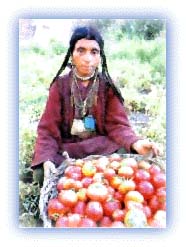Ladakh himalayas
General Info
· Villages
· Valleys and plateaus
· Dras Valley
· Dras
· Suru Valley
· Kargil
· Nubra Valley
· Siser La
· Tulimpati La
· Shyok Valley
· Murgo
· Burtsa
· Daulat beg Oldi
· Digar La
· Karakoram Pass
· Khardong La
· Indus Valley
· Chanthang Plateau
· Rupshu
· Salt Lake Valley
· Puga Valley
· Lakes
· Passes
· Glaciers
· Rivers
· People
· Religion
· Fairs and festivals
· Other places of interest

![]()
| People from the Nubra Valley The hard-working people have utilized every possible piece of land for habitation after constructing irrigation canals. The tree plantations around the villages enhance the beauty of these settlements, which look like oases in a barren desert. |
There is a clear impact of the Central Asian civilization of olden times, groomed and developed by the old "Silk Traders" of Yarkand who passed through with their big caravans. The important places along this route have been named in the Yarkandi language. Examples of this are Chungtash, Murgo, Kazilangar, Daulatbeg, Oldi.
 |
| Freshly picked tomatoes in the Nubra valley. Credit: Discover India |
The people rear yaks, goats and cows besides growing barley, potatoes and vegetables. Yaks are prized animals, with many uses. They are beasts of burden, their coarse wool is woven into thick black cloth to provide garments and tents, their milk is used to make butter and cheese, while the dried dung is used as fuel. This incidentally is the primary source of fuel in the remote region. The skins of the yaks are used for making leather, while yak meat is consumed.
Dressed in woollen robes, the women wear crudely tanned goat skins on their backs and heavy jewellery around their necks. Many sport fancy dog-ear fur flaps and turquoise studded head straps. Many women wear their finest jewellery even while working in the field.
All rights reserved